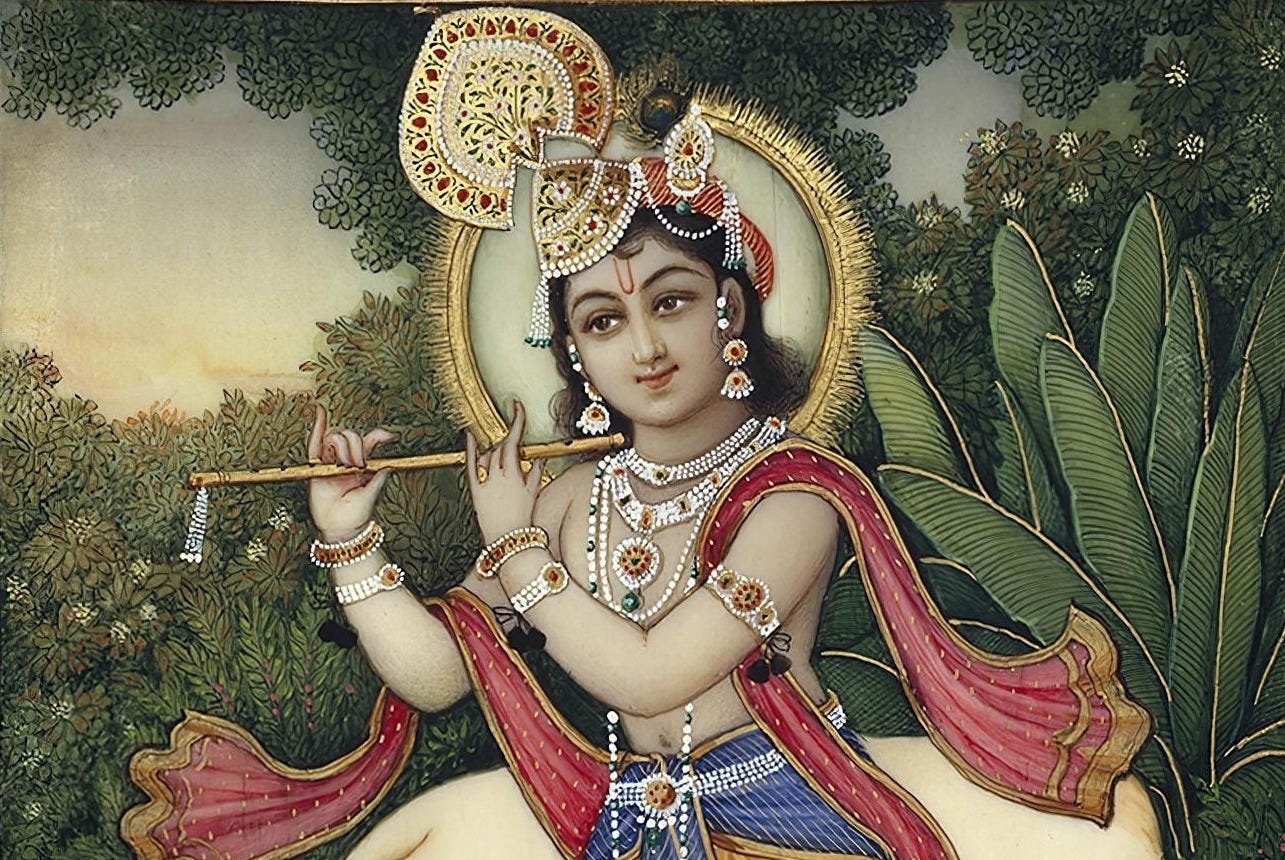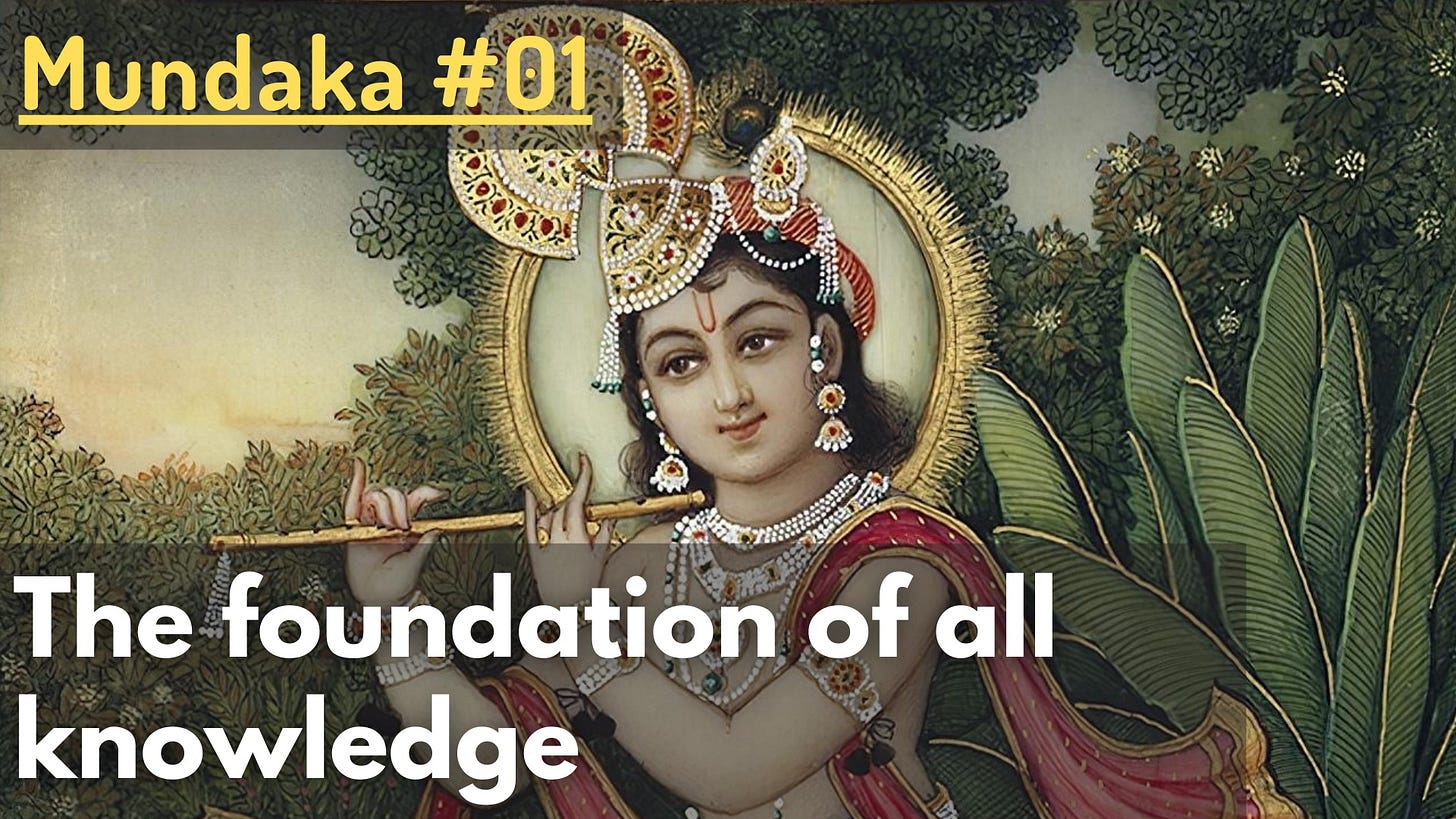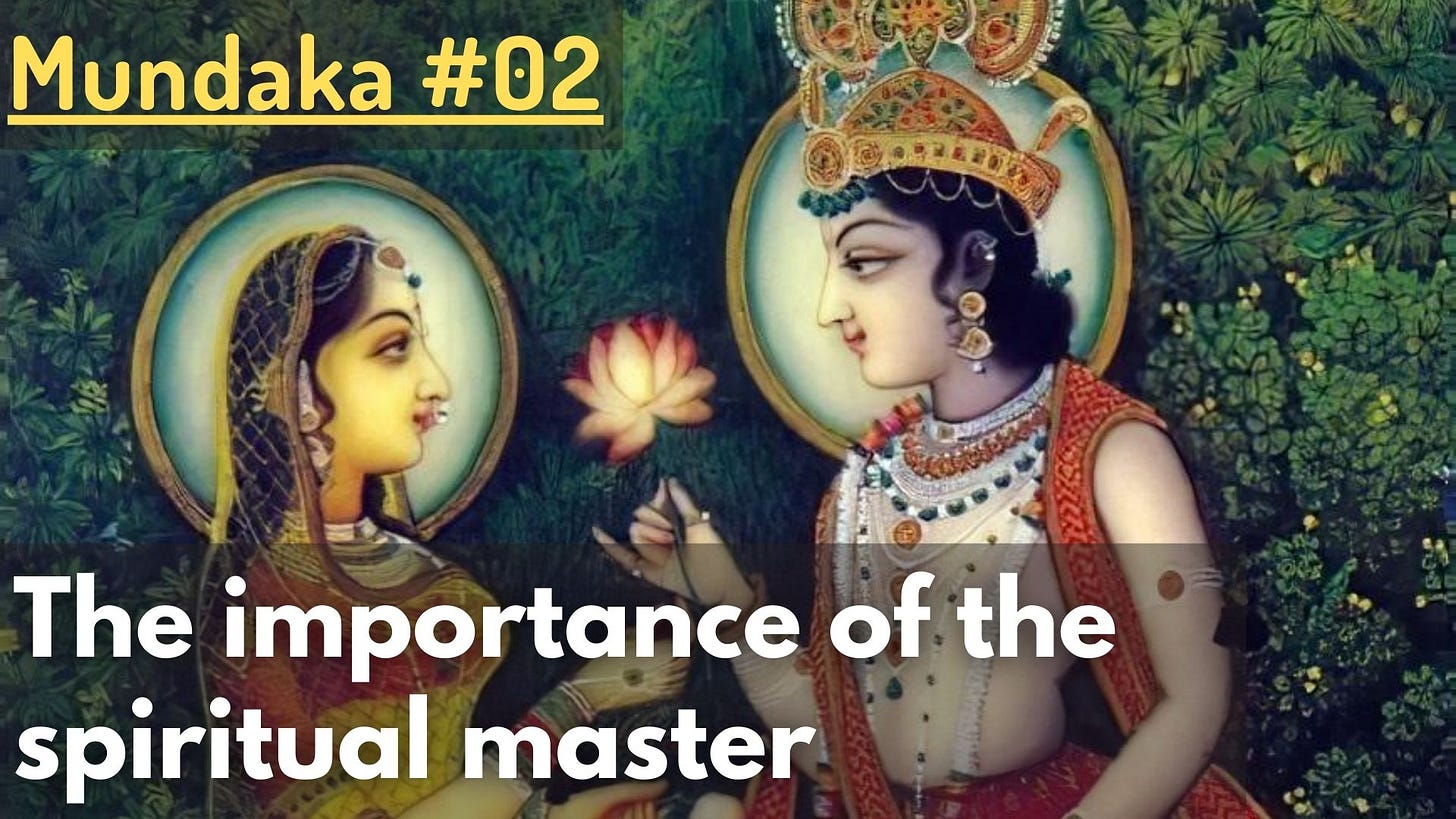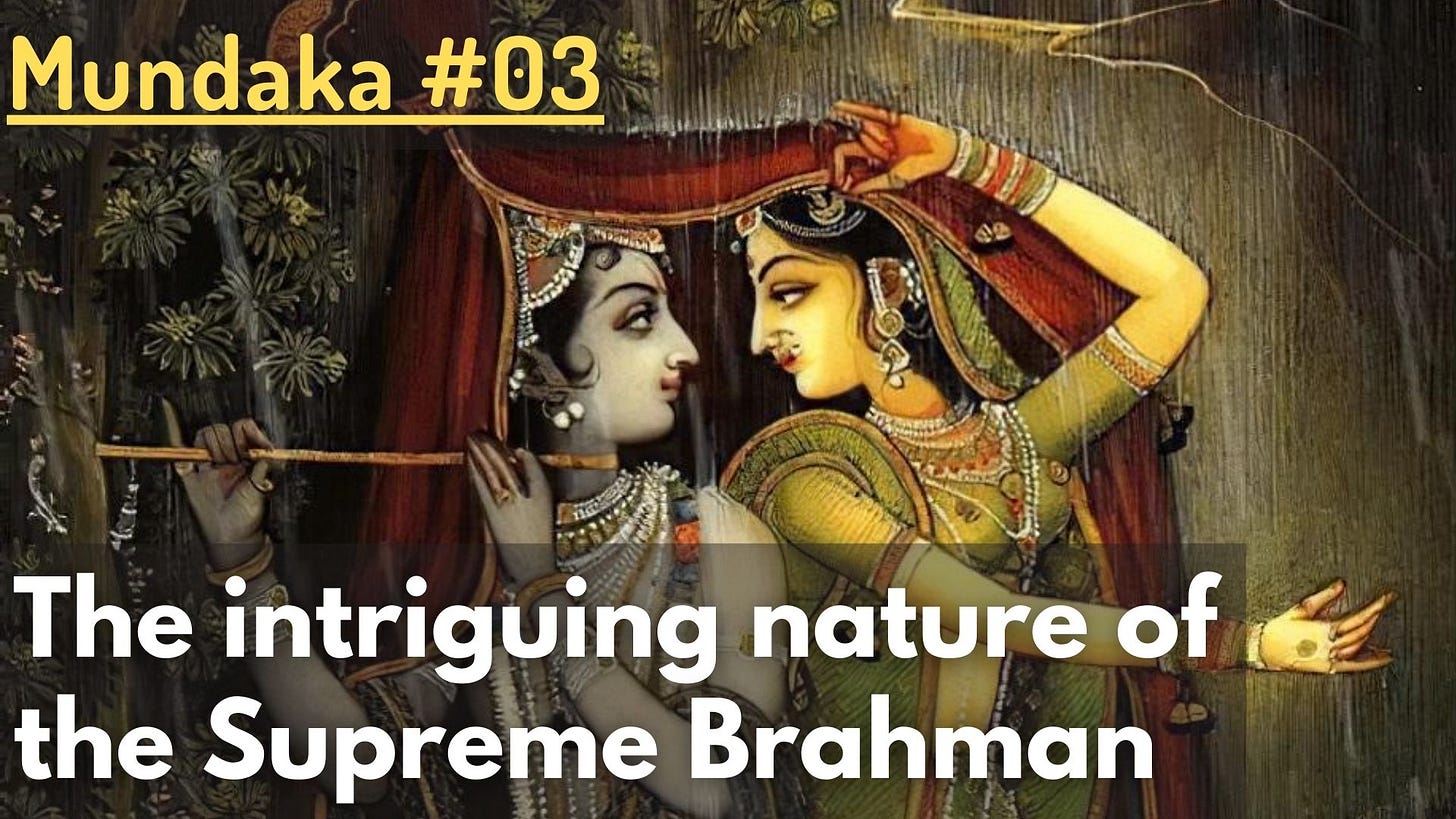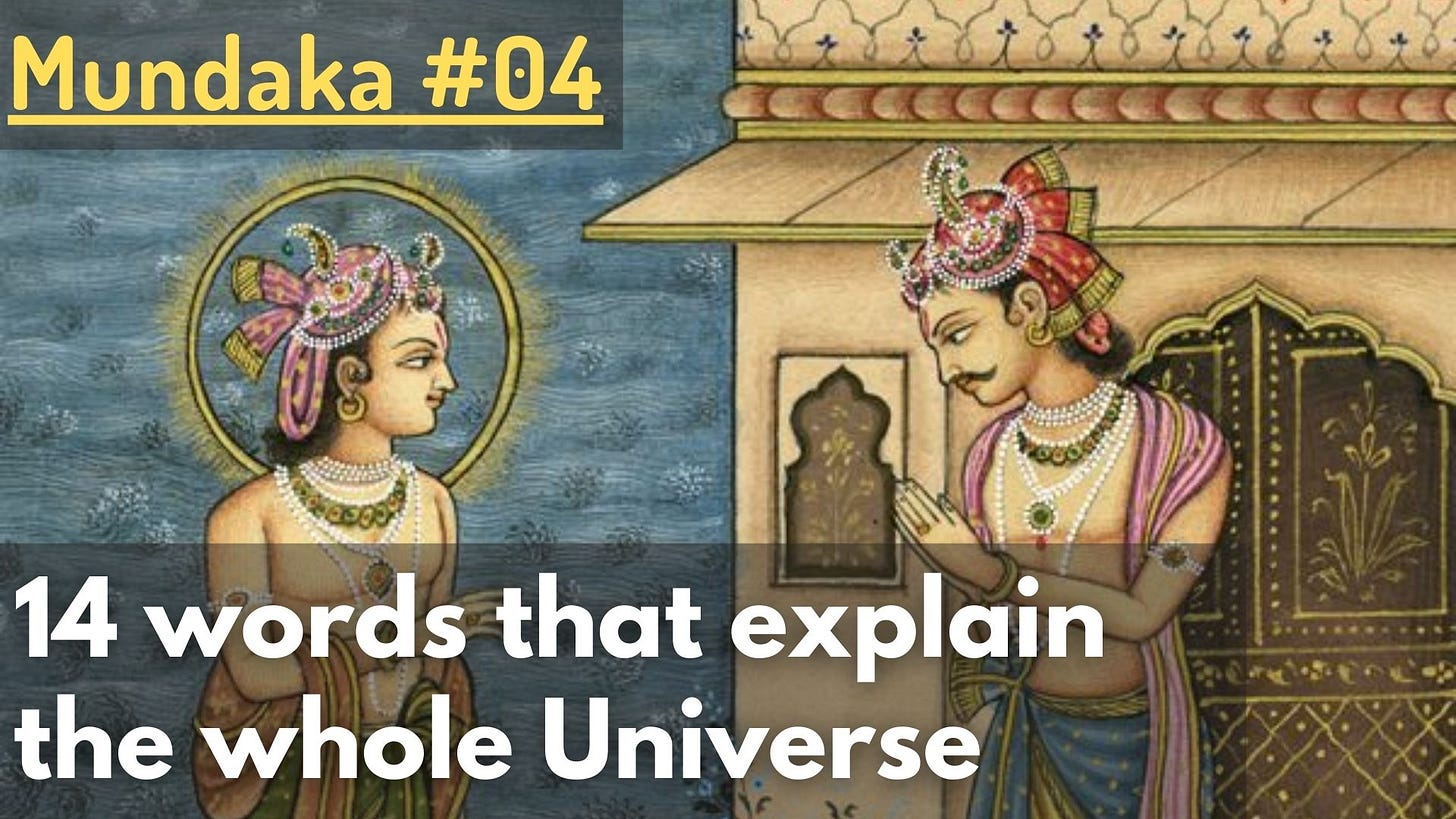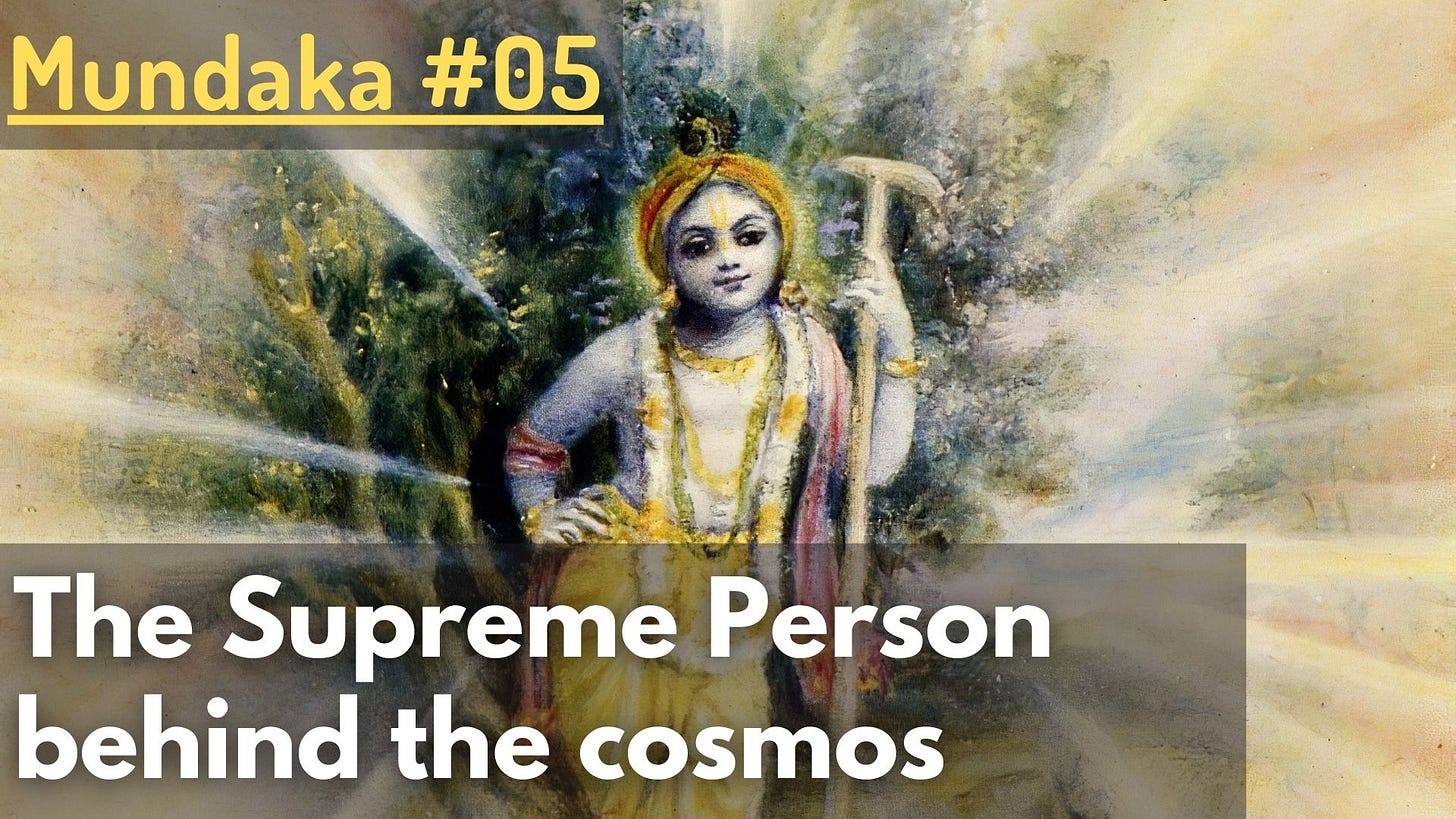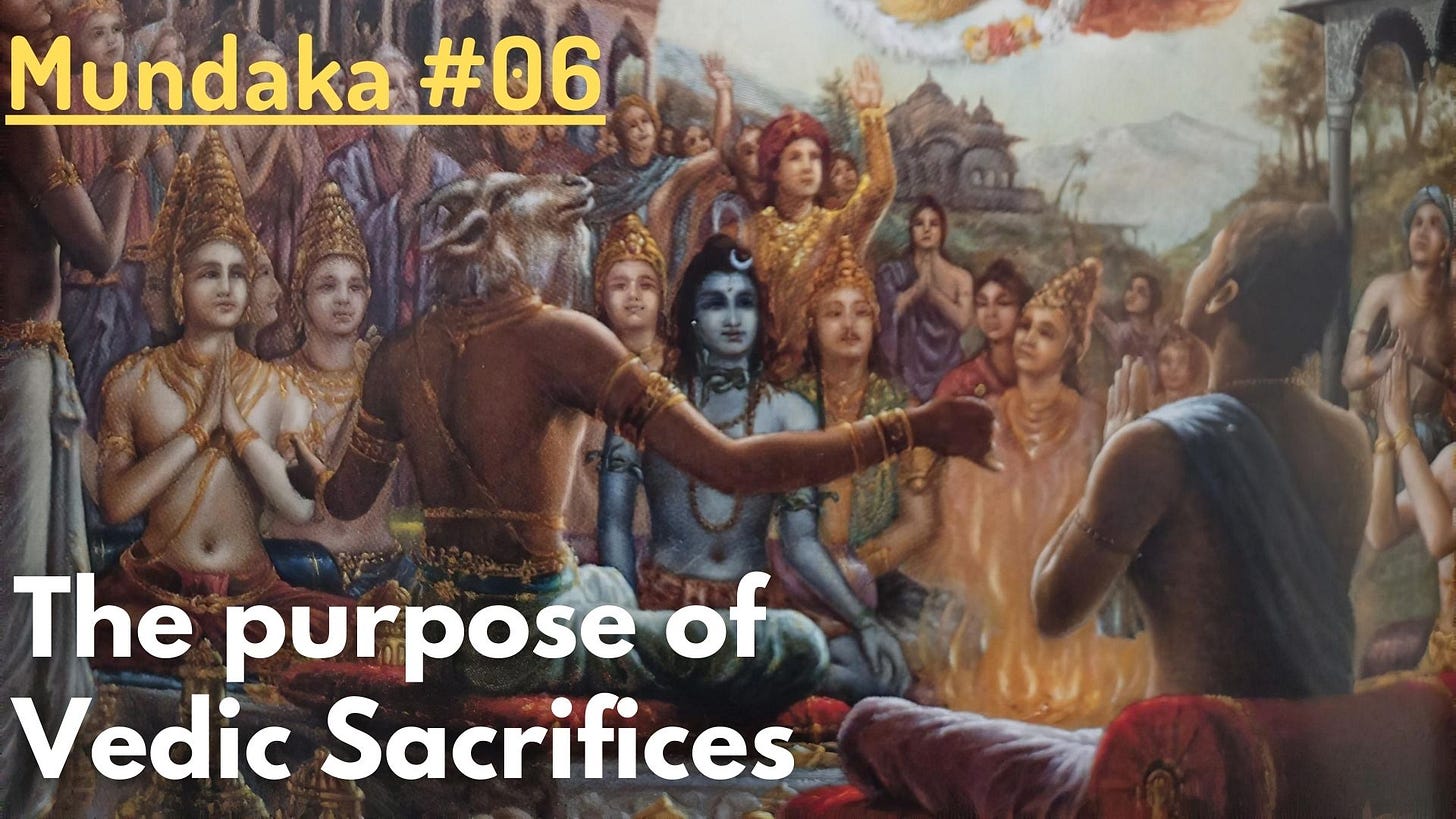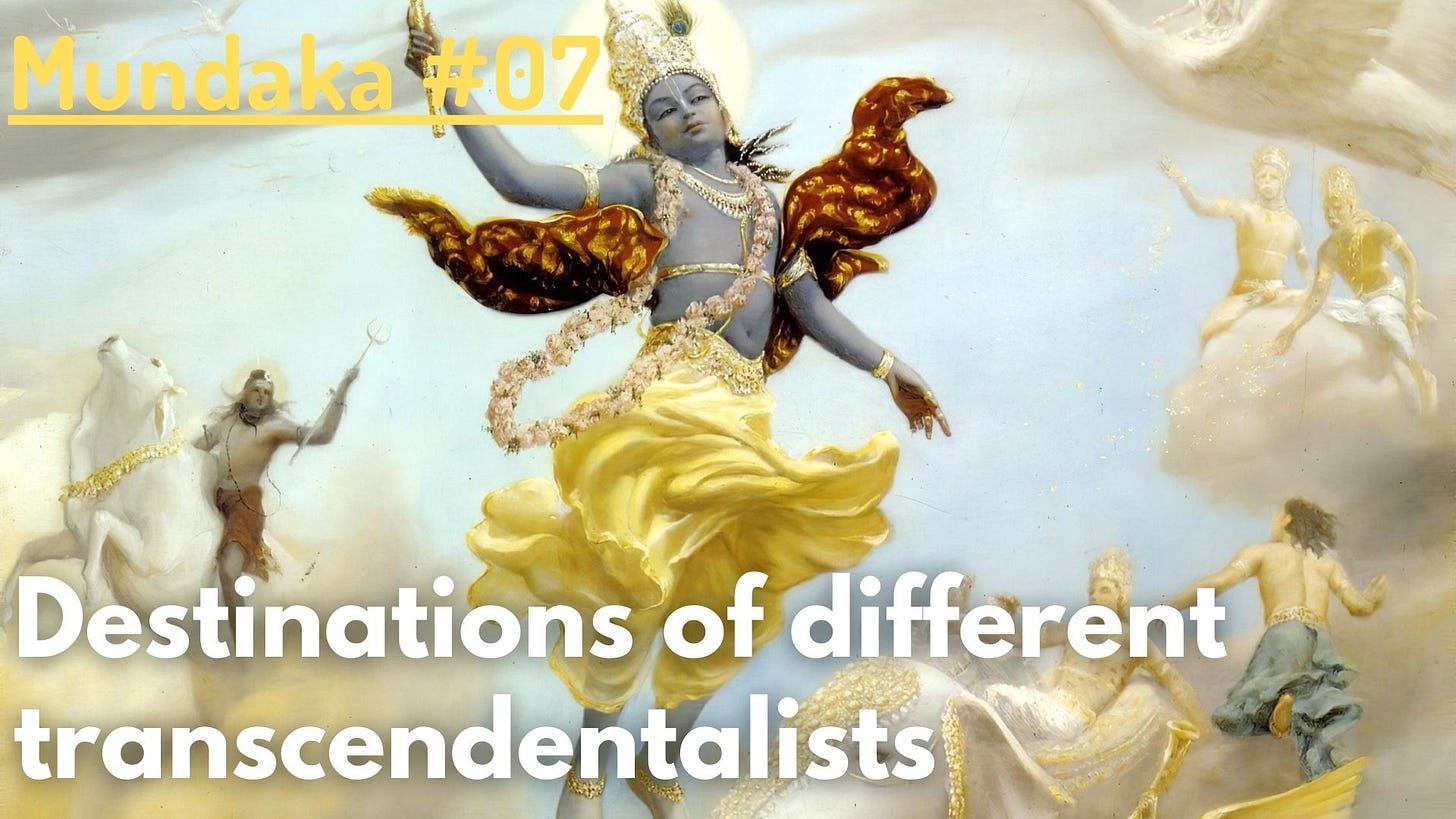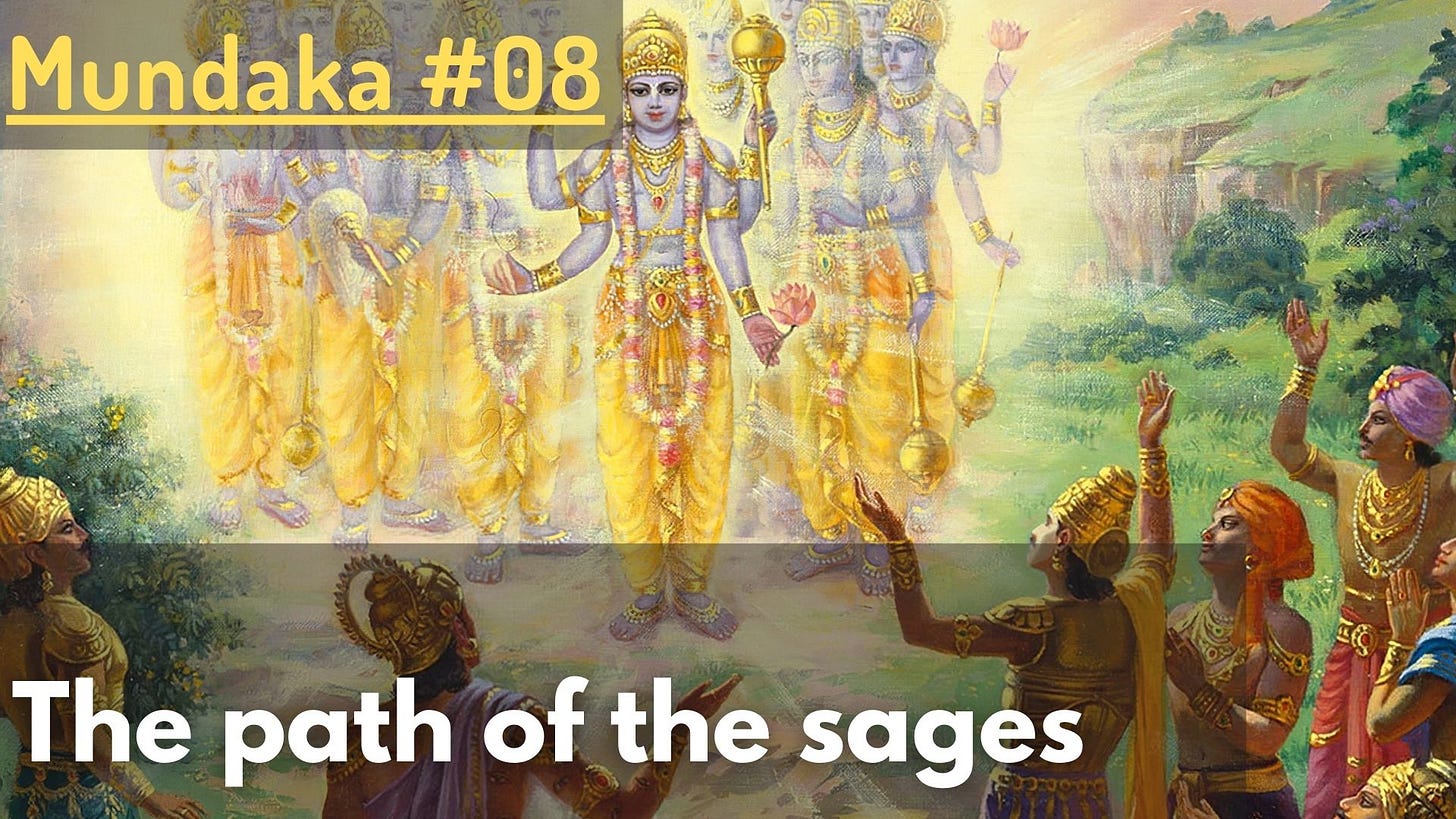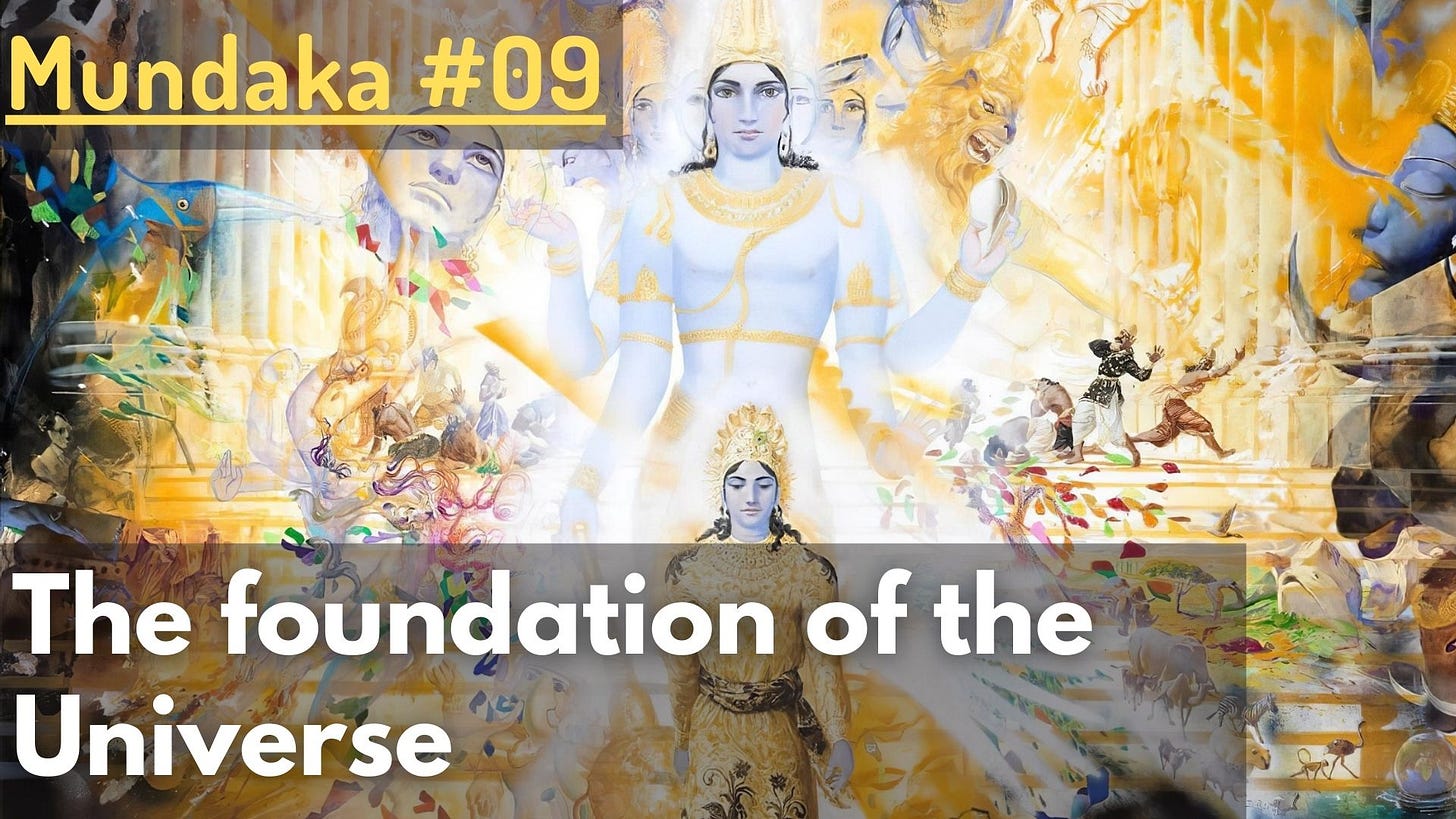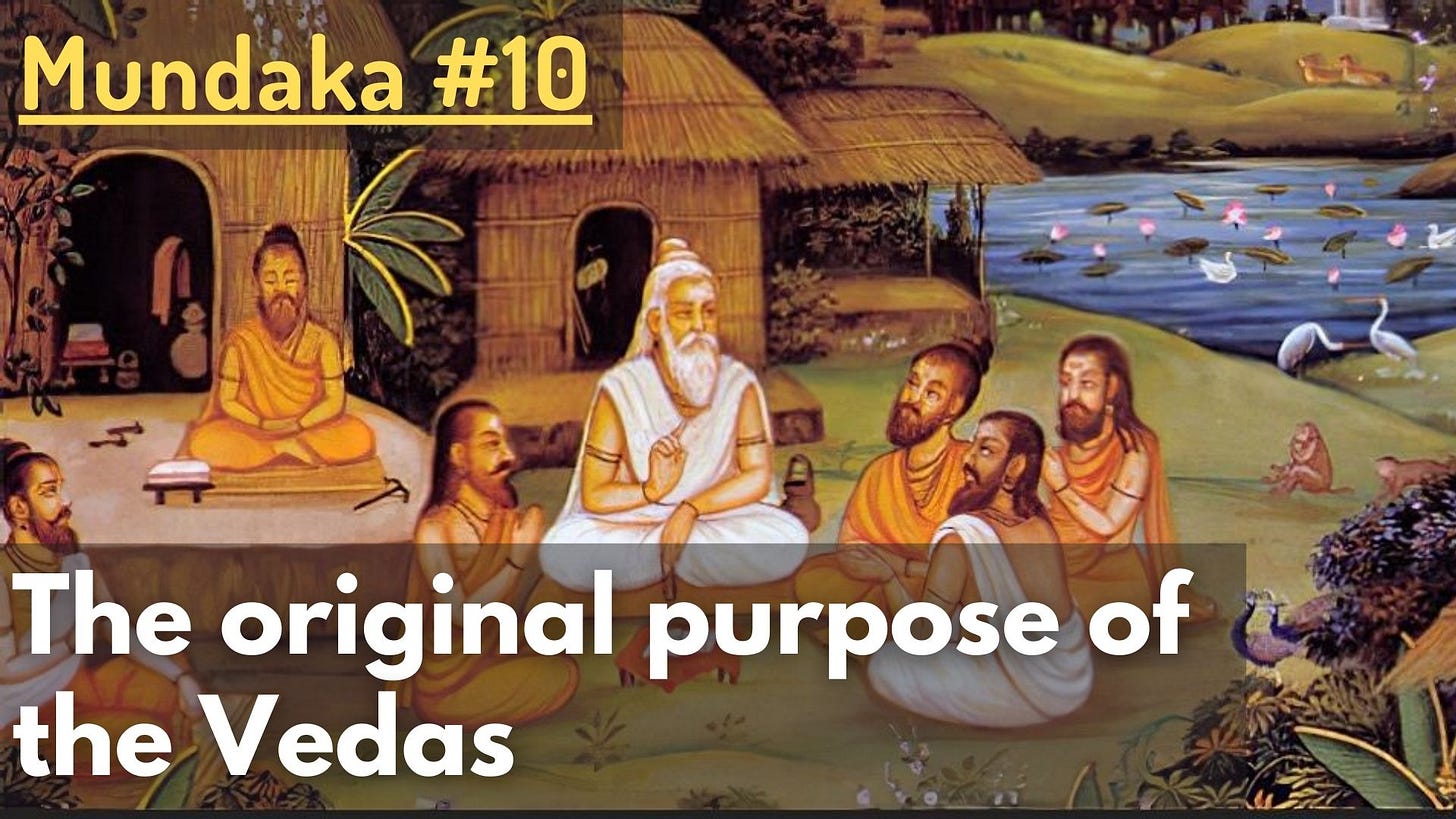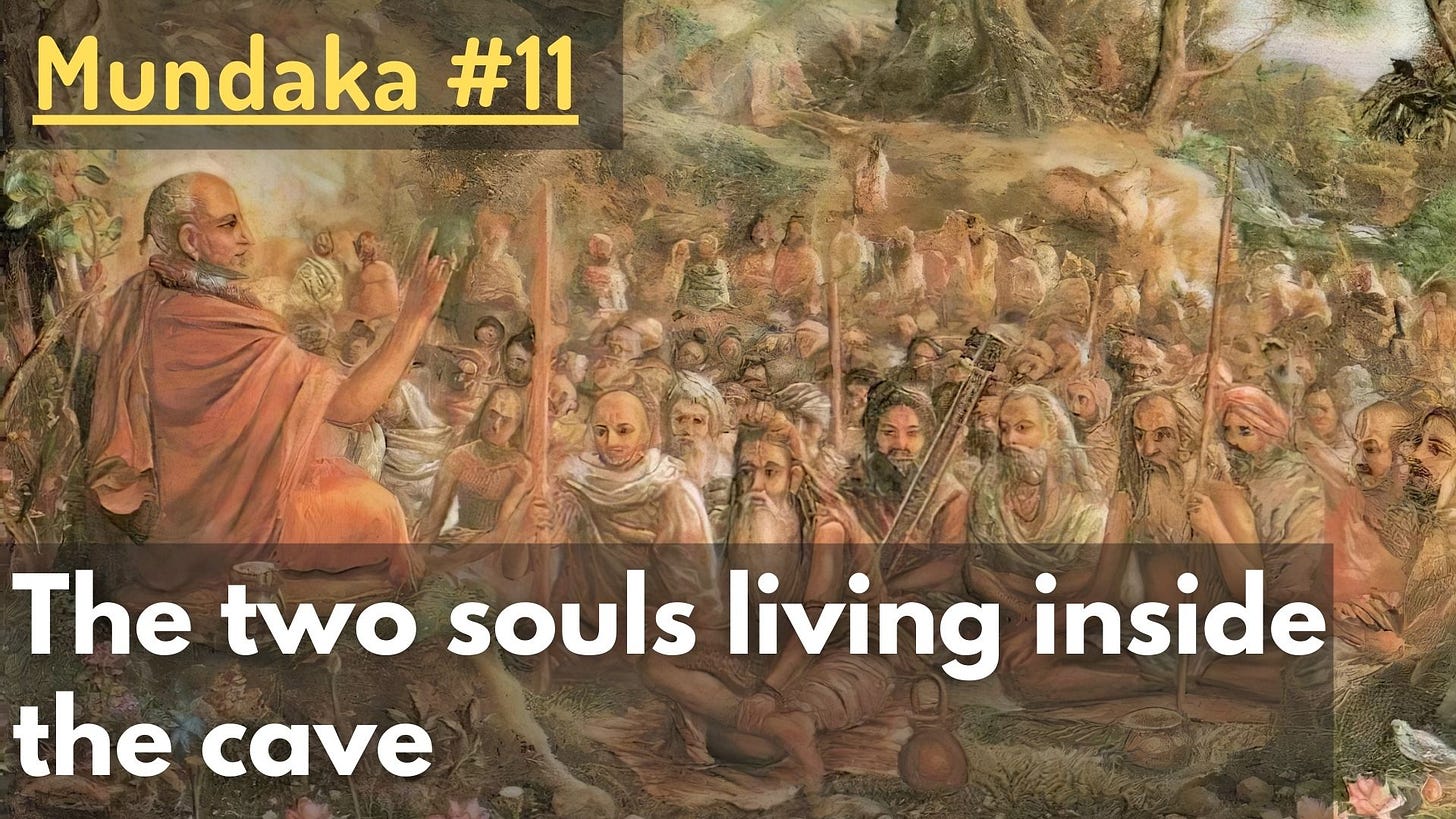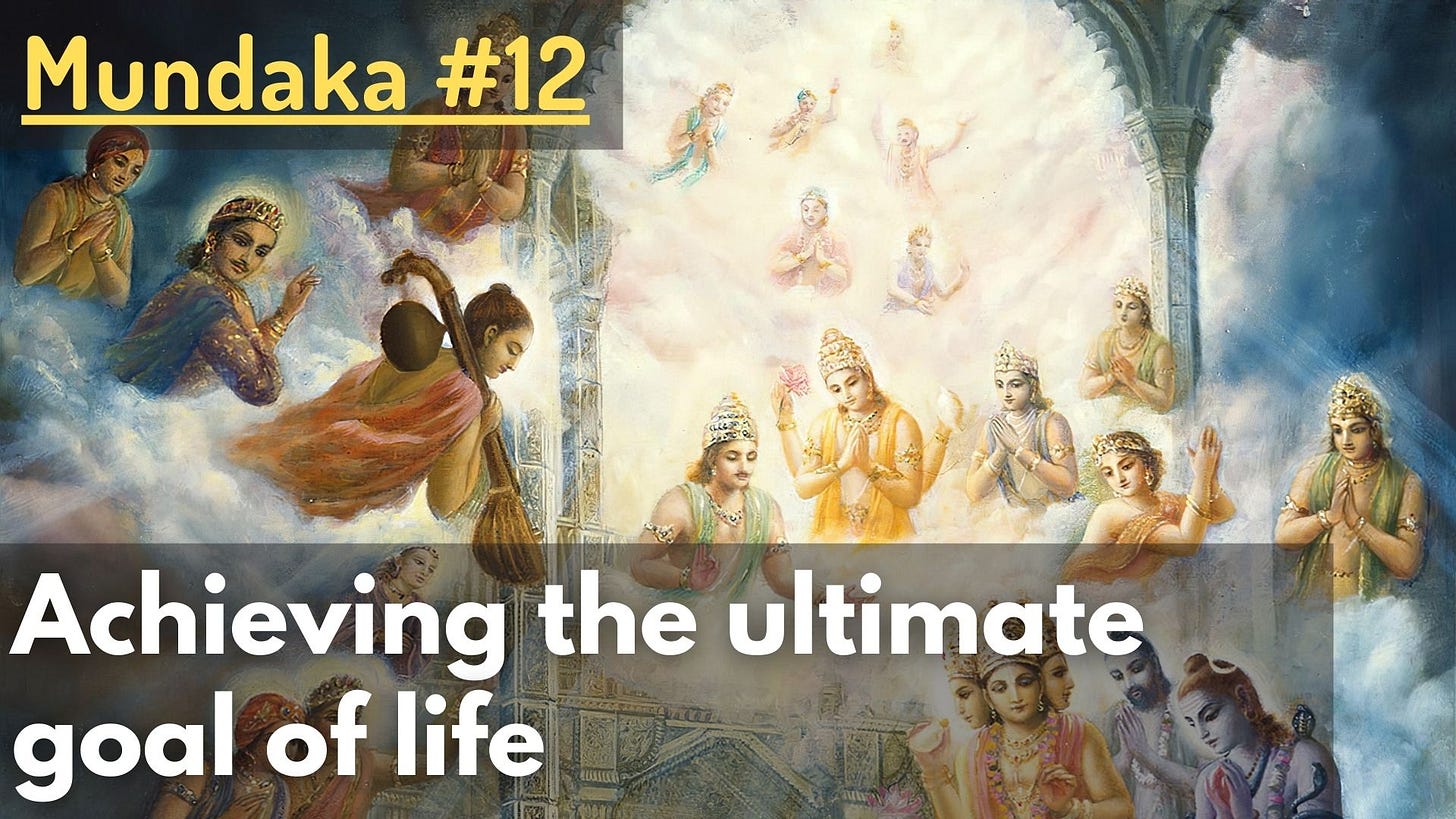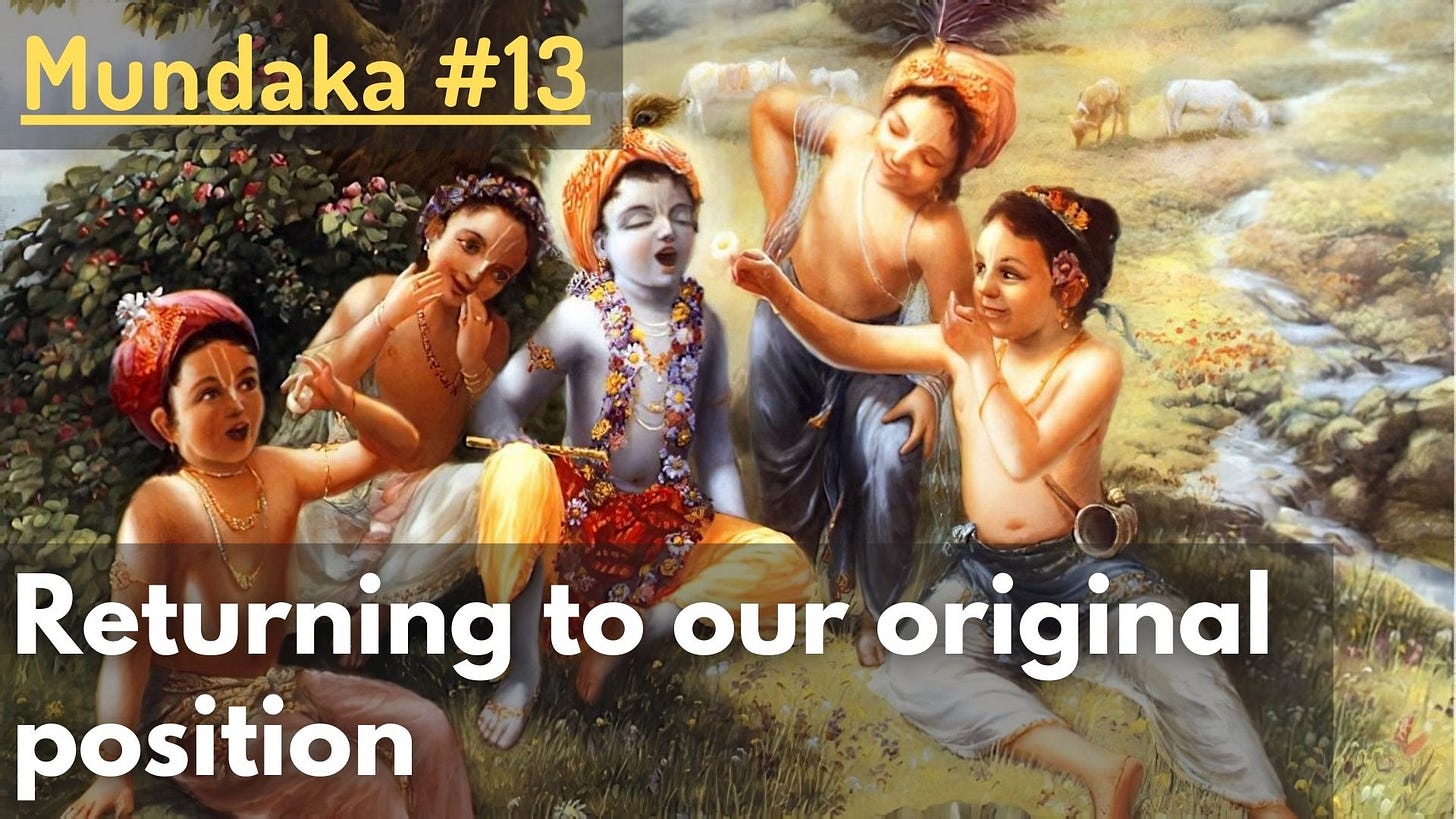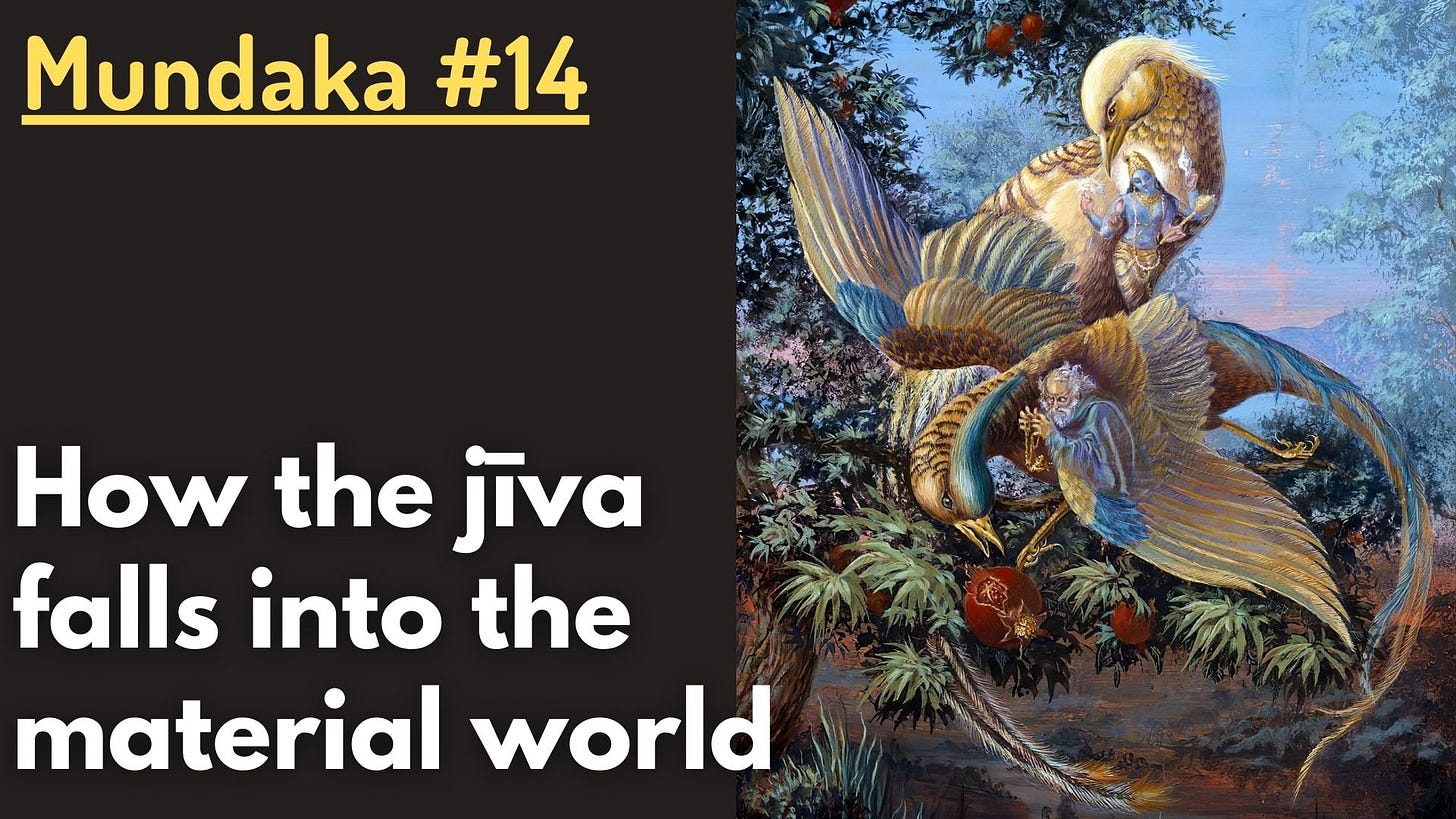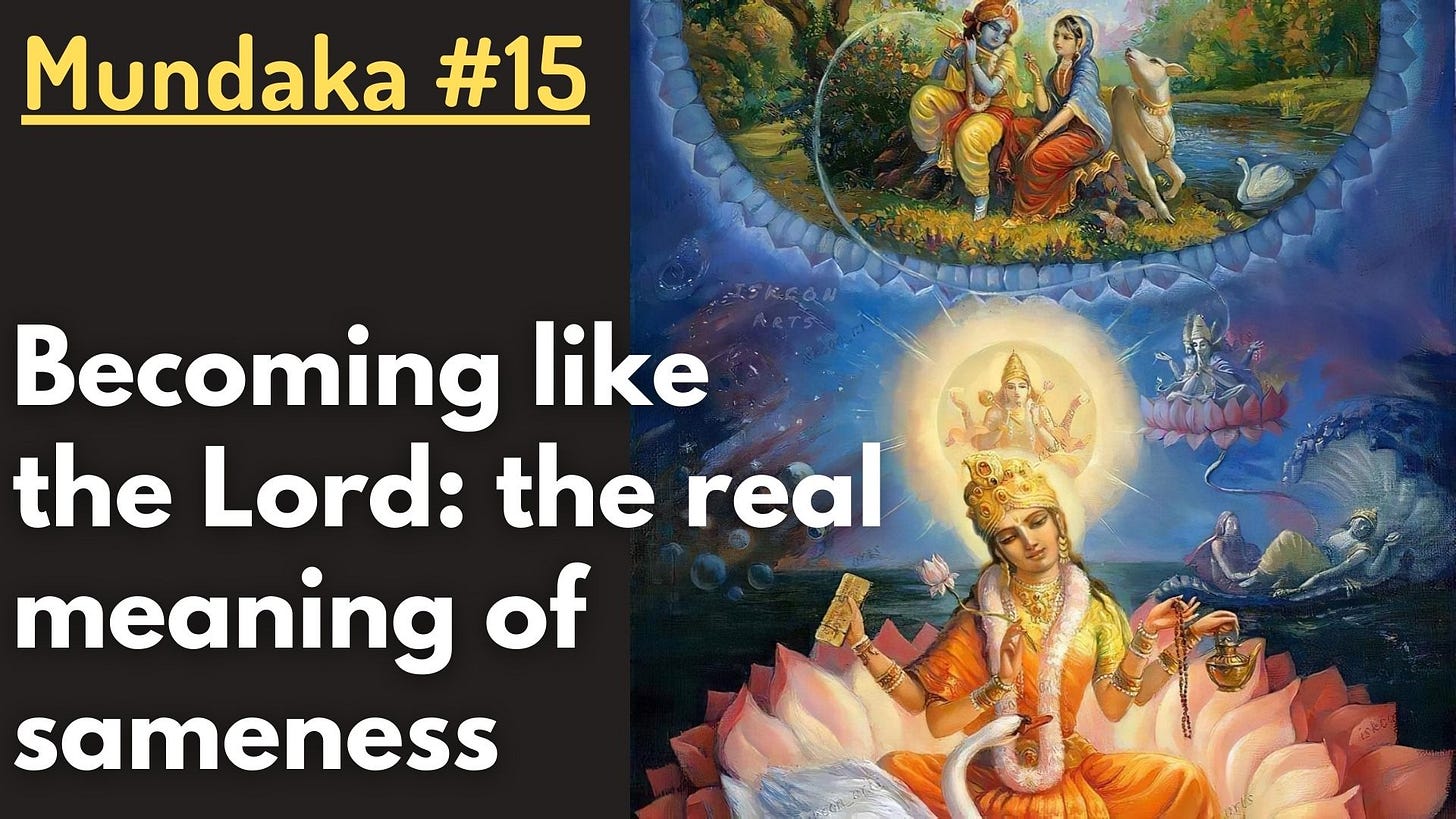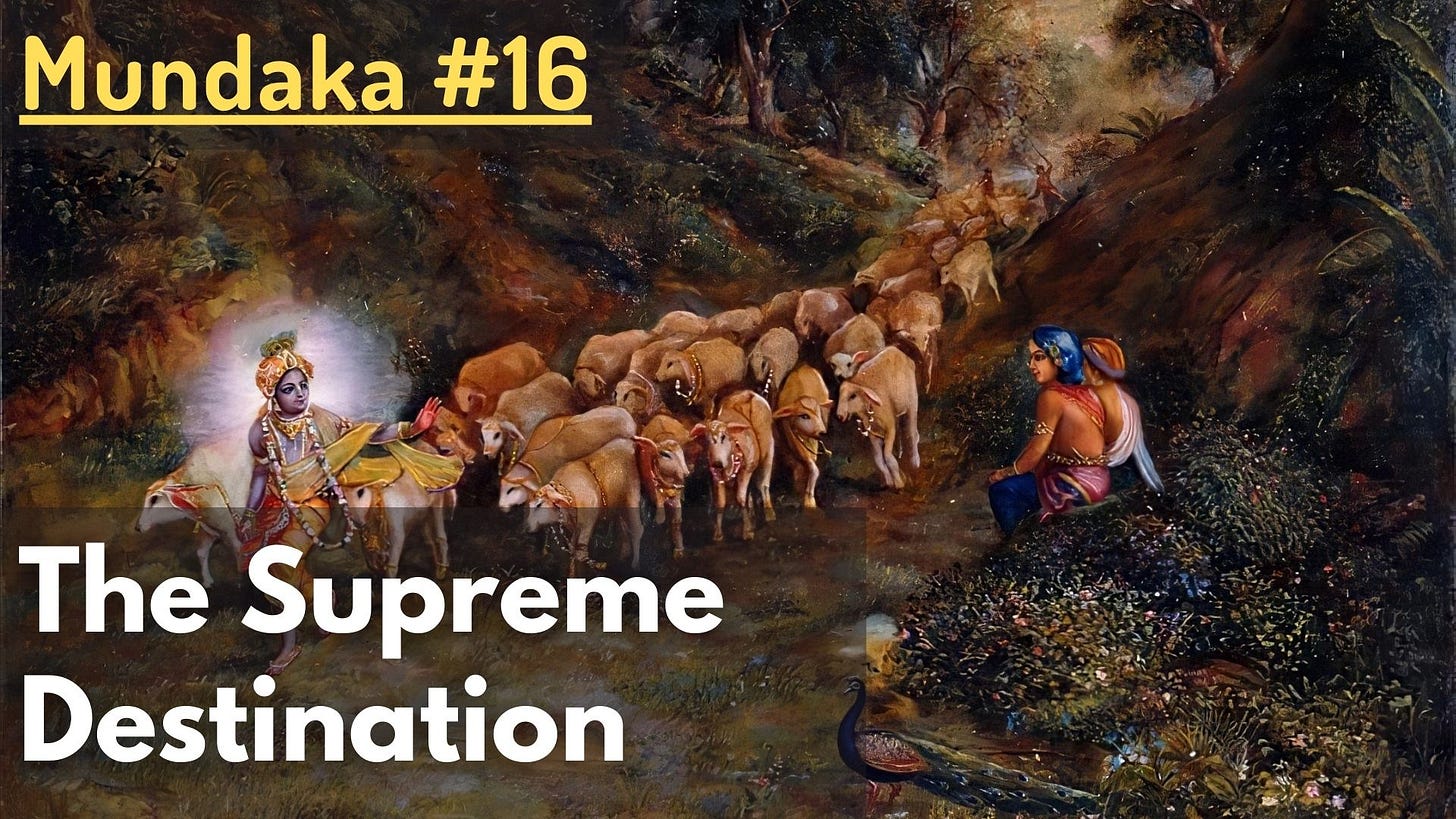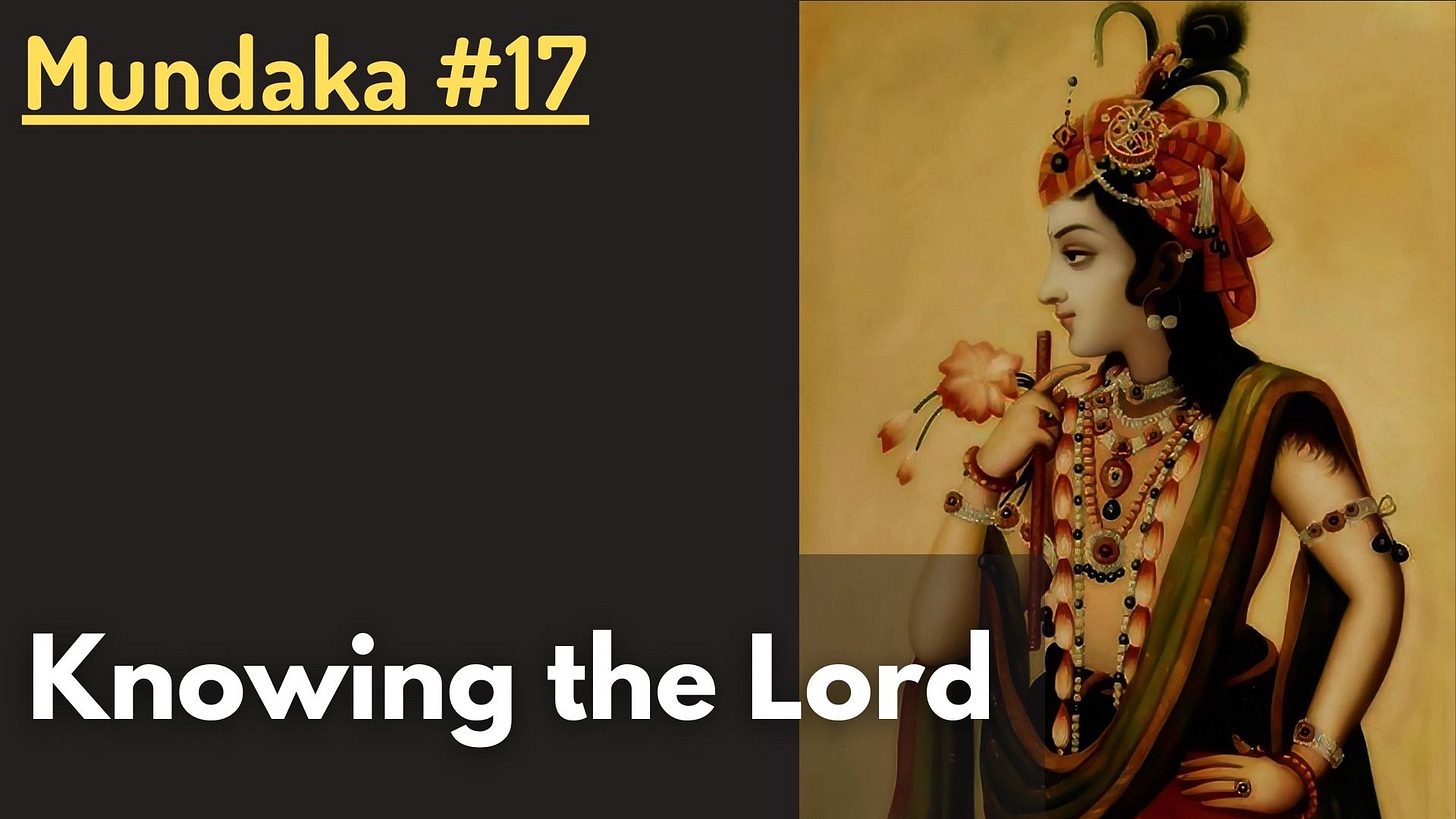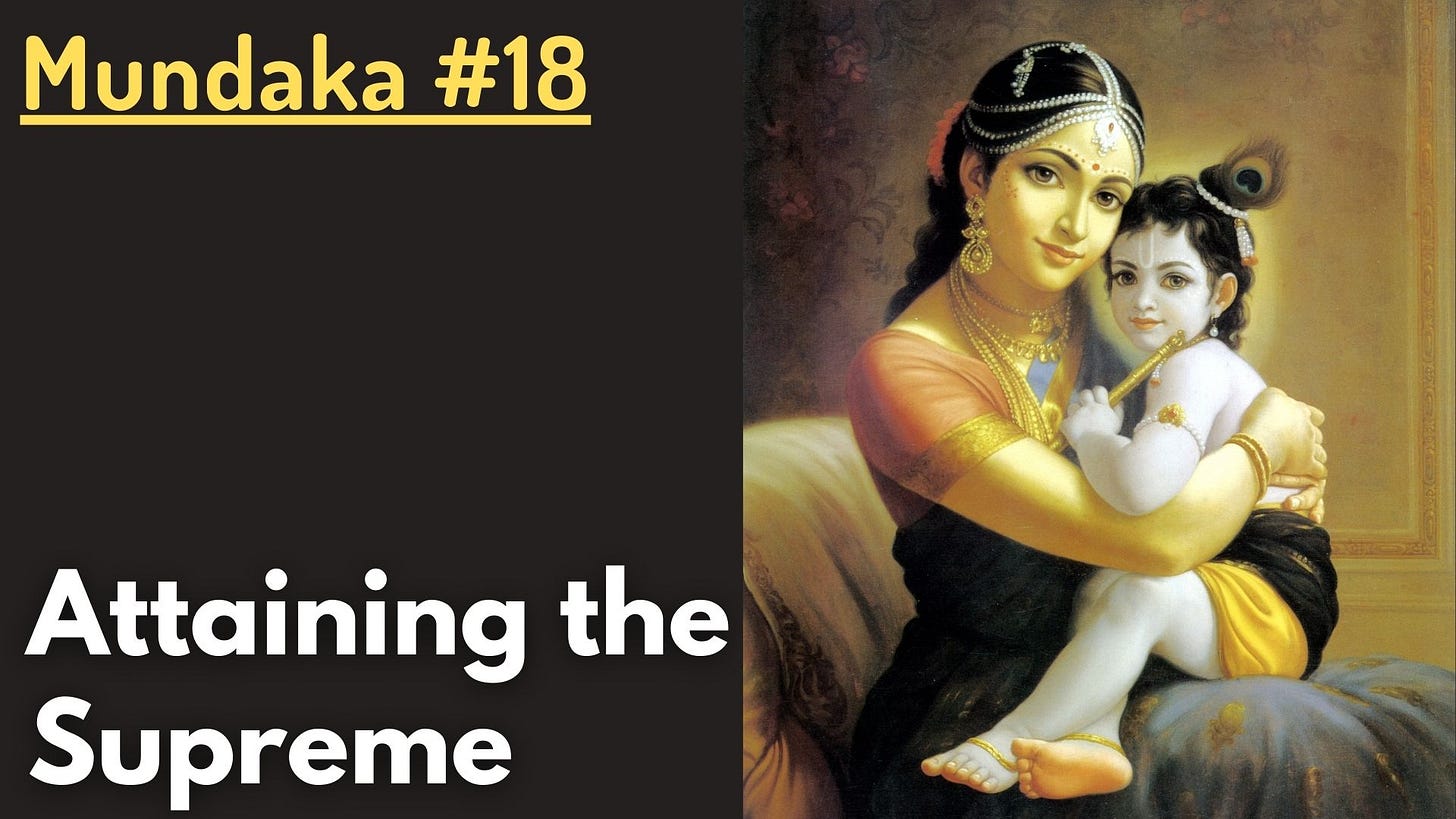Full Course: The Mundaka Upanisad
In this course, we dive deep into the meanings of the Mundaka Upanisad, and discover how the text hides the keys for understanding our eternal relationship with Krsna and devotional service unto Him.
The Muṇḍaka Upanisad is considered one of the cornerstones of the Advaita school. Śaṅkarācārya wrote an extensive commentary on it, which defined much of the basis of the Mayavada philosophy. Superficially, it indeed appears that many of the verses describe the impersonal aspect and impersonal liberation, but when we dive deep, we can see the verses actually describe the Supreme Lord in His personal aspect, the nature of the soul, and devotional service to Him as the supreme goal of life. In this way, this course offers not just an explanation of the Muṇḍaka Upanisad according to the Vaishnava school, but also a refutation of the Mayavada interpretation. It will also help you dive deeper into the meaning of the Upanisads and show you how to reach the deepest meaning of the texts.
Both Srila Ranga Ramanuja and Srila Madhvacarya wrote brief commentaries on the Muṇḍaka Upanisad, and Srila Baladeva Vidyabhusana explains the conclusions in his Govinda Bhasya. However, they are not easily understandable without the conclusions given by Srila Prabhupada in his books. It's only because Prabhupada explains the concepts discussed in the Upanisads in so much detail in his books that understanding the commentaries of the previous acaryas in their entirety becomes possible.
In this course, we dive deep into the meanings of the Mundaka Upanisad and discover how the text hides the keys for understanding our eternal relationship with Krsna and the process of devotional service that reconnects us with Him. You can also check the book with the full commentary.
» The nature of the Vedas and the Supreme Lord (Mundaka Upaniṣad #01)
The first part of a detailed commentary on the Mundaka Upanisad, based on the commentaries of Madhvacarya and Ramanujacarya.
Brahma is the first living being in the universe, created before the great sages and demigods. He is described as "prathamaḥ" (the first or foremost), "kartā bhuvanasya" (the creator of all living entities), and "goptā", the protector. This should be understood in the context of Brahma being subordinate to Lord Vishnu and receiving the mission of creating this particular universe. Understanding the proper context of each verse is essential in studying the Upanisads.
» The importance of the spiritual master (Mundaka Upaniṣad #02)
Even in Vedic times, there were many rsis and munis, and they would not be capable of understanding the absolute truth using their intellects. This proves that mental power alone is not sufficient to understand the scriptures and realize the Lord. After receiving some preliminary knowledge, one may acquire some faith, which can lead him to approach a qualified spiritual master, and then, under his guidance, he may deepen his understanding. This is part of a natural sequence explained by Śrī Caitanya Mahāprabhu Himself, as part of His teachings to Sanātana Goswami.
The intriguing nature of the Supreme Brahman (Mundaka Upaniṣad #03)
In this material world, we can observe that a creator is always different from the elements used in his creation. An artist may use paint to create artwork, a builder may use bricks to build a house, and so on. However, when we study the nature of the Supreme Brahman and the creation of the material universes, we come to an apparent contradiction. The Supreme Brahman is described in the Upanisads and the Vedas in general as both the efficient cause (nimitta) and the material cause (upādāna). In other words, Brahman is both the creator of the material manifestation and the substance from which the material universes are made. At the same time, Brahman is also described as unchangeable and unmaterial. If Brahman is spiritual and eternal, how can He be the cause of the temporary material world? If Brahman is unchangeable, how can He create the material manifestation out of Himself?
» 14 words that explain the whole Universe (Mundaka Upaniṣad #04)
The Upanisads are famous for bringing up complicated philosophical concepts in just a few words. Verse 1.1.8 of the Mundaka Upanisad is a surprising example, describing the whole process of creation and the workings of the universe in just 14 words! When the complete meaning is understood, we can appreciate the deep meaning of the verse, as well as better understand the way the Upanisads convey transcendental knowledge and the process of understanding it.
» The Supreme Person behind the cosmos (Mundaka Upaniṣad #05)
The real meaning of the scriptures, parā-vidyā, is the linking process of devotional service that connects us with the Lord. When one studies the scriptures starting from the conclusion that all verses describe Krsna and our relationship with Him, armed with the proper philosophical conclusions, received through the Parampara, he can understand the deep meaning of the verses, parā-vidyā. Otherwise, one gets just the superficial meaning and has the impression that the verses describe other subjects apart from Krsna, aparā-vidyā. This illustrates the importance of the work of Srila Prabhupada in his books, condensing the teachings of the previous acaryas in his purports and giving us the conclusions by which we can understand the scriptures.
» The purpose of Vedic Sacrifices (Mundaka Upaniṣad #06)
Materialists perform such fire sacrifices with the desire of obtaining fruitive results, such as material auspiciousness and promotion to the celestial planets. Often, due to a poor fund of knowledge, they can't even understand the purpose of the sacrifice, seeing the demigods as separate deities. When sacrifices are executed with material desires, they produce only secondary material results, which are temporary. Even such material results are uncertain because fruitive sacrifices produce auspicious results only when properly executed. When there are faults in the execution, they produce negative results or no results whatsoever. Even if such sacrifices are successful, the material facilities obtained will remain only for a short time, being lost at the time of death, if not earlier. Even if one attains the celestial planets, one will have to come back to Earth after exhausting his pious credits. Such persons as described by the Lord in the Bhagavad-gita as alpa-medhasām (men of small intelligence), who take the endeavor of executing costly sacrifices without obtaining their true fruit.
» Destinations of different transcendentalists (Mundaka Upaniṣad #07)
Sacrifices performed with perfect knowledge and without material desires carry the performer to the spiritual sky. This pure performance of sacrifice is true renunciation. However, when one doesn't have the proper understanding, he is instead elevated to the higher planets, up to Satyaloka. As Krsna mentions in the Gita, one's destination follows his mentality and process of worship. Sacrifices thus grant different results according to the mentality of the performer. Fruitive activities are offered in the scriptures simply as a way to attract the masses and gradually lead them on the path of self-realization. Despite considering themselves intelligent, the performers of these ritualistic sacrifices are defined as fools, who miss the true goal of the Vedas, which is devotional service to the Lord. Material duties and pious activities are supposed to be performed in the spirit of karma-yoga, as a matter of duty, without attachment to the results, as explained in the Bhagavad-gita. When performed in this spirit, they gradually elevate us to the platform of devotional service. However, if one performs them for fruitive results and promotion to the heavenly planets, one fails to gain any permanent results.
» The path of the sages (Mundaka Upaniṣad #08)
Opposite to the karmi, who is mad after sense gratification, is the renounced sage, who has firm faith and fully dedicates himself to the practice of devotional service, purified of all material desires. Such a pure devotee escapes the cycle of birth and death and attains the Lord. After many lives as a karmi, going through the process of performing fruitive activities and being elevated to the celestial planets, just to be tossed back, one starts inquiring about spiritual knowledge. He then approaches a bona fide spiritual master in all humility. Without receiving true spiritual knowledge from a self-realized soul, one will have access to just the superficial meaning of the verses of the scriptures, and will thus never be able to reach the ultimate conclusion. Conversely, by receiving brahma-vidyā, perfect spiritual knowledge, and practicing these instructions, the sincere student can finally attain ultimate perfection.
» The foundation of the Universe (Mundaka Upaniṣad #09)
Although the Lord has no material form, as declared in the previous verse, He is the source of the material manifestation. Having originated from the energy of the Lord, the material creation is in one sense a manifestation of the Lord, and thus yogis who are not capable of conceiving His personal form are advised to meditate on the universe as a form of the Lord, with the higher planets forming His head, the sun and moon His eyes, the Vedas as His speech, etc. This understanding also helps us to realize how everything is connected with the Lord and how everything comes from Him. It is also a way to facilitate our meditation on Him, seeing the Lord everywhere we look. When we can perfectly understand the concept of the universal form, we can, literally, see the Lord anywhere we look. At the same time, however, the universal form is more or less imaginary, since, as declared, the Lord has no material form.
» The original purpose of the Vedas (Mundaka Upaniṣad #10)
Both the original purpose of the Vedas and the path of fruitive sacrifices come from the Lord, just as all living beings, the sources of sustenance, and spiritual qualities and practices. The material bodies of the living entities are very complicated machines, composed of the senses and mind, intelligence, vital air, etc., and all of these were created by the Lord, together with the sense objects. In other words, the Lord is the creator of both the world and the means we use to explore this world, and He is present in all these creations as the Supersoul. He also created the different types of duties prescribed in the scriptures by which one can progress in spiritual realization. One who comes to know this Supreme Lord, situated inside the heart, can cut the knots of ignorance that bind him to this world.
» The two souls living inside the cave (Mundaka Upaniṣad #11)
Both the Lord and the jiva reside inside the heart, but they are not the same. One is infinite and the other infinitesimal, one is the whole and the other the part. The individual soul is thus meant to serve the Lord. There are many eternals, but the Lord is the chief. During the day, when awake, we become immersed in all sorts of activities, but at night, when in deep sleep, our consciousness retracts to the cave of the heart, where we meet the Lord, just as in liberation. In all scriptures, many qualities of the Lord are mentioned, which make it impossible to negate His personality. Thus, both the Lord and the jiva are separated individuals, and they are so eternally. It is exactly the individuality of the Lord and the soul that makes the eternal relationship between them possible.
» Achieving the ultimate goal of life (Mundaka Upaniṣad #12)
Using the bow of the holy names, we should send our mind in the direction of the Lord, just as an arrow shot toward a target. This arrow of the mind should be sharpened by devotion to the Lord and not allowed to deviate to anything else. By this fixed meditation, we can attain the Lord, entering the spiritual sky, just as an arrow enters its target. The process of chanting should be practiced with fixed attention and the proper attitude of surrender. What happens after entering the spiritual sky? We remain as individuals and serve the Lord in one of the five types of transcendental relationships. The soul remains an individual even after entering the spiritual sky, just like a molecule of water entering the ocean or a bird entering a tree. There is no question of merging anywhere. This process of chanting the holy names and serving the Lord with a devotional attitude is the path of self-realization for all ages, it is just practiced in different ways. We should thus give up other talks and forms of worship and fix our attention on this supreme process of worship of the Supreme Lord, the refuge of liberated souls.
» Returning to our original position (Mundaka Upaniṣad #13)
The Lord is one, but He appears in many forms. He is present in His abode and inside everyone's heart. Possessing multiple, inconceivable potencies, He is the source and the maintainer of everything, and He is the foundation of all sources of light. Because the Lord has potencies and qualities, it is undeniable that He is a person. Conditioned life means ignorance, and this ignorance and darkness keep us away from the Lord. However, when illuminated by the light of transcendental knowledge, we can perceive the Lord's transcendental form. When this realization is obtained, all karma is destroyed, and we become free of all material contamination. All material designations appear as the result of the false ego, and when this root cause is cut, we can again see ourselves as pure souls.
» How the jīva falls into the material world (Mundaka Upaniṣad #14)
The Lord and the jiva living inside the heart are compared with two birds living on the same tree. Both share the same transcendental qualities, but one falls into illusion and becomes absorbed in eating the sweet and bitter fruits of the tree, while the other maintains His transcendental position. There is no meaning in the relationship between the soul and the body, but this connection is somehow established due to illusion, just as someone dreaming. Forgetting Krsna, the soul has been attracted by the external potency of the Lord from time immemorial. When the living entity forgets his constitutional position as an eternal servant of Kṛṣṇa, he is immediately entrapped by the illusory, external energy. The Lord is the master of this illusory energy and remains untouched by it. Because He remains transcendental, He can help the soul to return to His transcendental nature.
» Becoming like the Lord: the real meaning of sameness (Mundaka Upaniṣad #15)
We may be right in front of someone, but if we are looking the other way, we will not see him or her. Similarly, the Lord is not only present everywhere, but He personally follows every soul present inside the heart. As long as our attention is turned to material enjoyment, however, we don't see Him. When we finally turn our attention to the Lord by our practice of Krsna Consciousness, this eternal relationship is reestablished. The soul thus becomes just like the Lord, free from material contamination, and attains the Supreme destination. By reconnecting with the Lord, we become blissful in His association, and by sharing this with others, we become dear to Him. Sameness doesn't mean merging, but the similarity of qualities and interests, and living in the same location. This is explained in the Chandogya Upanisad, in the history of Śvetaketu and his father, Uddālaka. Mayavadis take the passage "tat tvam asi" as meaning that the soul and the Lord are one, but they are mistaken.
» The Supreme Destination (Mundaka Upaniṣad #16)
The Lord is a person, and His form is fully transcendental, beyond the reach of the material senses or intelligence. We can first conceive this unlimited, perfect form through the descriptions of the scriptures, and later by direct perception using our spiritual senses, as our spiritual consciousness awakens. Just as the Lord has a transcendental form, He has also transcendental activities. When we become situated in the transcendental platform, saturated with pure love, we can join these transcendental pastimes. Attaining this level of purity may appear inconceivable in our current state, but when the Lord is pleased by our service, we become endowed with all spiritual qualities. The Lord can take the soul out of material contamination and grant pure devotional service to anyone at any stage, but He does so only when one sincerely desires it. As long as this desire is not there, He respects the free will of the soul.
» Knowing the Lord (Mundaka Upaniṣad #17)
The Lord doesn't directly get in contact with the material energy, but at the same time, the whole material creation rests on Him. Everything depends on Him, but He doesn't depend on anything, therefore, He is the Supreme abode. He is situated in the spiritual sky and never comes in contact with matter, but at the same time, He becomes present through the reflection of His energy as Lord Garbhodakasayi Vishnu and Ksirodakasayi Vishnu, just as the sun reflected on a pot of water and then on the walls of a room. The infinite Lord can simultaneously permeate all material universes, while the infinitesimal soul can permeate just a single material body. Just as the Lord is present in the material world as a reflection, the pure devotee can see himself also present as a reflection of his original consciousness, reflected in the three divisions of the false ego and permeating the body, senses, and mind.
» Attaining the Supreme (Mundaka Upaniṣad #18)
Material intelligence can help us to make plans and act in this world, but it can't help us to realize the Lord. The Lord is completely free and independent and can be understood only by one whom He chooses. Therefore, the process of mental speculation is not useful for understanding the Lord; He can be understood only by devotional service. We should thus abandon material attempts and try to become pure devotees of the Lord. When we sincerely practice the path of bhakti, starting from the observance of regulative principles, spiritual knowledge is revealed to us. Only when our senses become purified by constant devotional practice, the truth of the Lord's pastimes, form, qualities, etc., is revealed.
» The final conclusions of the Mundaka Upaniṣad (#19)
The knowledge of the Muṇḍaka Upanisad was spoken by Angirasa to Śaunaka Rsi long ago, but this knowledge remains up-to-date and relevant, just as other vedic texts. It teaches supreme knowledge, brahma-vidya, which can lead us to perfection. This knowledge should be taught only to qualified students who have abandoned the path of fruitive activities and are now aiming for spiritual realization in devotional service. After being reinstated in his original Krsna Consciousness, the soul shines in his original spiritual qualities.



